
Notre Dame's Grotto / by Dorothy V. Corson

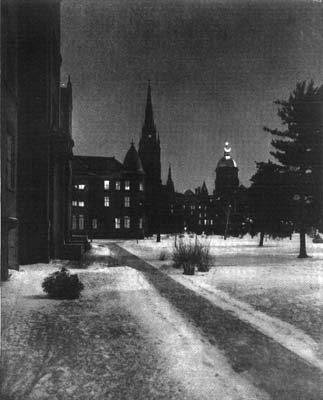
Our Lady is on the Dome!
On April 23, 1879, eight months after Sorin's Our Lady of Lourdes Grotto was dedicated, the second Main Building was destroyed by fire. An eye witness to the atmosphere during the 1879 fire gives a firsthand account.
The force of contrast has been strikingly illustrated by two circumstances connected with the fire. One is the tall chimney of the steam-house, which seems so very tall since the college has disappeared from its front. Standing without relief among the little buildings that are left, it seems to have suddenly shot up into the blue sky. The other contrast to which we refer is the striking of the clock in the Church tower during the burning of the College. At twelve, at one, and at two the solemn strokes were sounded as usual, but with almost supernatural effect upon the ear, as if the clock of eternity were knelling the conflagration of the globe and the destruction of all things. Time marked its ceaseless course through the terrible burning, even as it had done in the hours of peace, study and prayer. We shall never forget that bell, unruffled and peaceful, as it was heard, and barely heard, amid the crackling and roaring of the flames, the falling of walls, the noise of the engine, the rushing and hissing of water and the loud shouts of men -- the peaceful but appalling sound of these sweet church bells striking the hours of God's ever passing time, His quiet, all-embracing Eternity. (70)
In the concept of God's ever passing time, it is sobering, to be reading those words more than one hundred years later.
Tom Schlereth's book on the Main Building, A Dome of Learning, reports the fate of the Blessed Virgin statue atop the first dome:
The fire spread rapidly across the roof to the base of the wood and tin dome which, when its supports burned away, collapsed under the weight of Sorin's beloved statue and carried the fire into the building's interior.(71)
The 1879 Scholastic also reported another work of art
destroyed in the fire:
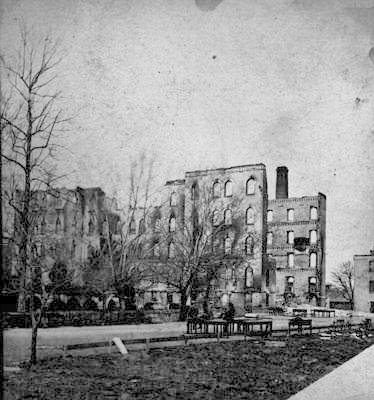
Among the many precious works of art destroyed in the College Chapel by the late fire was the solid silver ostensorium, two and a half feet high, elegantly chased and embossed, which was a gift to Rev. Fr. Carrier from ex-Empress Eugenie. All that remains of this once beautiful object are a few lumps of molten metal found in the ruins.(72)
Once again, Father Hope records Sorin's characteristic spirited response to the disastrous fire: "I wouldn't care, even if we had lost everything! We will begin again! The Mother of God cannot be defeated!" As Father Hope put it, "It was like a grand pep talk between halves."(73)
Whatever the odds were, Sorin always knew he could count on Our Lady.(74)
The Rededication of the New Notre Dame
Because of delays, the rededication of the "New Notre Dame," planned for September 8, 1879, the Feast of the Nativity of the Blessed Virgin, was postponed. A solemn High Mass was celebrated on that day instead, at the beginning of the school session, less than five months after the fire. Rev. W. Corby, President of the University, addressed eloquent words of instruction and wisdom to the students.
Education without religion or moral training, is a very dangerous thing. It is like a sharp tool in the hands of an infant. The tools in themselves are good, fit for use by those who know how to handle them, but destructive to those who know not how to use them -- even death dealing, at times, to the infant. So education without moral training is one of the most dangerous instruments used by the enemy of man's salvation for a greater destruction -- death to the souls of men.
Every day we read of crimes, . . . not committed by the uneducated only; no, but by those who had received an education above the common, but devoid of moral training. . . . While these men's intellects were well trained, the heart and the morals were neglected. . . . It is time for the educators of the country to take this matter into consideration. The sooner they do, the sooner we may look for a nation of citizens whose lives will be an example of truth, honor, justice, and all that makes men noble. . . . It must therefore be the aim of all true educators to develop the moral as well as the mental faculties in those committed to their charge.(75)
Stories abound about the new colossal statue of the Blessed Virgin created for the new Dome. It arrived on campus in the summer of 1880. It was placed on the front porch of the newly constructed Main Building -- a Lady in waiting -- until the Dome was prepared to receive her statue. For three years she adorned the porch awaiting ascent to the top of her pedestal on the finished Dome.
Many local families have passed on family remembrances of ancestors who helped hoist the statue to the Dome, as many farmers of the day must have done. Records show they often joined forces in assisting their neighbor, Notre Dame, with tasks that required man and horse power. Similar stories were passed on regarding the building of the present Grotto.
One descendent of an alumnus of those days, Mary Roemer, remembers hearing a family story of how the statue of Our Lady was brought by wagon from the train station pulled by a team of six or eight white horses. "Sounds like a fairy tale, doesn't it," she said. She explained that it was just a long ago remembrance. She had no way of knowing where it came from.
It's a story that could easily have been true. The heavy statue would have been transported from the train station by wagon. Such a momentous ceremonial occasion might have warranted a team of all white horses.
No confirmation of her story has been found, but another amusing anecdote about an uncompromising Father Sorin turned up in an unpublished manuscript in the University Archives. It was written by the first Father J. W. Cavanaugh. He describes Father Sorin's vision of Our Lady atop a Golden Dome and his unrelenting efforts to accomplish it.
When the council repeatedly refused Sorin the Dome and Our Lady, Father Sorin rose and with a fine blend of dignity and indignation gathered up his breviary and his pajamas, or whatever was used for pajamas in those days, and started to St. Mary's. Over there just off the regular parlor was a small room called by the irreverent the "Puppy-hole," in which Father Sorin often retired to recite his office without distraction. Father Sorin took up his post there and remained for two weeks like Achilles skulking in his tent, declaring that never would he return to Notre Dame until he was allowed to carry out his plans for the big dome carved with a beautiful figure of Our Lady.
In desperation the members of the council decided that they had better yield. A committee was sent to St. Mary's with their hats in their hands to beg Fr. Sorin to return, assuring him he could have his dome.
There will be those, of course, who will find something less than perfect in the religious attitude of Fr. Sorin throughout this episode. It is fair enough that they should have their opinion. Others will marvel at what seems to be the uncompromising spirit, the hardheadedness, the obstinacy of a man, whose great role of a founder and builder of a college in a wilderness must have been a reasonable compromise. Whoever looks at the beautiful campus now and considers how different the whole thing would appear without the dome will hesitate to entertain either suggestion. The truth is that the dome upon the Administration Building assembles all the other buildings on the campus around it and contributes to each a dignity which, otherwise, it would not possess.(76)
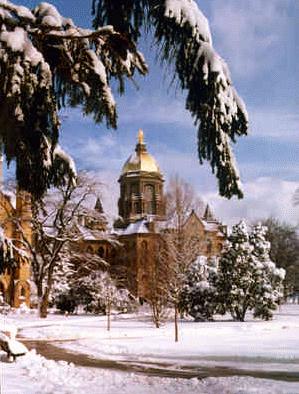
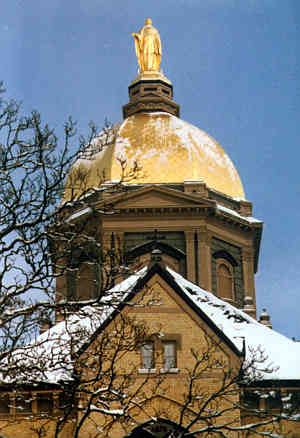
Raising the Statue to the Dome
The work of raising the statue to its present position was skillfully accomplished by Mr. Alexander Staples, of standpipe fame,(77) who engineered putting it on the Dome. It took two days. The 1879, Scholastic published a description of the statue:
We have received a description of the proposed statue of our Lady which is to adorn the new University, and which the young lady graduates(78) of St. Mary's Academy generously proposed themselves to contribute as their crowning gift to Notre Dame. The model of the statue is that adopted by our late Holy Father, Pope Pius IX, in 1854, on the occasion of the solemn proclamation of the dogma of the Immaculate Conception (erected by Pius IX in front of the Propaganda College in Piazza di Spagna in Rome). The material will be of highly polished bronze, sixteen feet in height, the crescent with the serpent beneath, and a starry crown above. Nine of the stars will be seen over and on either side of the head. By day the statue itself and its circle of stars will glitter in the sunlight, an object of beauty for miles around; and by night the nine stars will be lit with the electric light, and thus be a beacon of beauty from a still further distance. As the head will be 186 feet above the earth [sources vary on this; 197 feet seems to be the correct figure],(79) it is evident that the jets of light will be seen by night all over the neighboring city and for a great distance on the various railroads entering here.
The young ladies of St. Mary's have therefore undertaken a beautiful task, a labor of love, in thus placing our Lady's statue in mid-air, as Michael Angelo placed the faultless Grecian temple above St. Peter's, a thing of beauty to rest and shine there, a joy forever. May their labor of love be rewarded, here, with the success of the object which they have in view, and afterwards with the sweet memory of the noble deed which they have accomplished, and may our Blessed Lady look upon them with her brightest smiles when, as the shades of night come on, her beautiful statue lights up the landscape of Notre Dame and St. Mary's!(80)
Marion McCandless in her book, Family Portraits, reports on this project which was proposed the same year the St. Mary's Alumnae Association was founded, in 1879. She then mentions the fact that this first project proposed by them was accomplished only in part by the alumnae.(81) It is not clear from surviving records if others at St. Mary's made up the difference or whether Sorin obtained the rest from other sources.
Tom Schlereth in his book, A Dome of Learning , states that it was "purchased largely from bequests from Mother Angela Gillespie's Holy Cross sisters, women students and alumnae of Saint Mary's Academy."(82)
Another source seems to validate Schlereth's statement:
Mother Angela sent a circular letter to the Sisters commanding, not requesting, each of them to raise twenty dollars toward the restoration of the main building at Notre Dame. Gifts poured in from friends, alumni, merchants, other educators, benefactors of all ages, places of residence, and economic levels. The Saint Mary's Academy alumnae officers began collecting funds to put a bigger statue on a bigger dome. The new building opened on time in September, not complete, but usable.(83)
In 1883, the Scholastic described in detail the placing of the statue on the Dome:
The great event of the past week was the placing of the colossal statue of the Blessed Virgin on the Dome of the University. . . . As announced in the Scholastic, a short time ago, the exterior work of the Dome was finished, and everything was ready for the statue. On last Monday afternoon, the statue was lowered from the front porch and brought to the rear of the College. There it was allowed to remain until the apparatus necessary for raising it to the summit of the Dome could be prepared. Everything was ready by Wednesday noon and that afternoon, slowly but surely, the grand figure ascended to the roof of the College. On Thursday work was resumed, and at length, at five o'clock p.m., amid the ringing of bells, the statue was seen to rest firmly and securely on its grand pedestal.
The statue is the work of the late Mr. Giovanni Meli, of Chicago, and is the largest of its kind in the United States. It stands sixteen feet in height and weights 4,400 lbs.
"The statue is on the Dome!" was the general exclamation, last Thursday night. Few and simple were the words, yet they contained a wealth of meaning. They announced the accomplishment of long-cherished desires of the heart, the filling up of a void long too open at Notre Dame, the crowning act in the public expression of honor to her under whose patronage this Home of Religion and Science is placed.
Notre Dame -- "Our Lady." These two short words speak volumes in explanation and praise of the motive which has led to the erection of this glorious monument to the Mother of God . . . . More than three years have glided by since Notre Dame passed through its fiery ordeal, and the time was well employed in preparing for the erection of a monument which would be, as far as loving hearts and willing hands could make it, a fitting expression of gratitude, and the most glorious of its kind in the country.
And now these desires are realized. Today this grand statue, so familiar to the visitor and student at Notre Dame, stands upon her magnificent throne, and, with extended arms, gives the assurance of the continued protection of her whom it represents.(84)
The golden dome was finished on September 26, 1883. The following month the statue of Our Lady . . . was hoisted, on a trough by block and tackle, to its throne 207 feet above the earth. One year later her crown and crescent were electrically illuminated thus making Notre Dame the first college to use such lights. Edison had discovered the incandescent globe on October 21, 1879 after spending two years testing over 6,000 substances and spending $100,000 in search of the proper filament. It is said that the Notre Dame statue of Our Lady became also the first airplane beacon light visible in five states.(85)
A picture of the "circle of electric lights crowning her head and the moon at her feet" appeared in the first Notre Dame yearbook, the 1906 Dome. A poem from the same era describes Our Lady's crown and crescent, "emblazoned in a halo of Electric Glory."
|
Night comes and sets thy beacon in the skies A woman starry-crowned, with starry eyes, That watch forever with a solace meet, Above the glimmering moon beneath her feet.(86) |
When floodlights were introduced that would adequately illuminate the statue, the crown and crescent were removed, and Our Lady was forever to be seen as she is today, aglow with light.
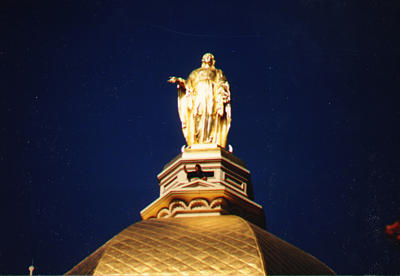
The Gilding of the Dome and Statue
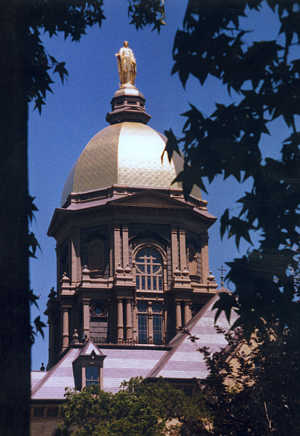 The Dome and statue were accomplished in 1883. A year later the crown
and crescent were added. Three years later, in 1886, the Dome and
Statue were gilded for the first time.
The Dome and statue were accomplished in 1883. A year later the crown
and crescent were added. Three years later, in 1886, the Dome and
Statue were gilded for the first time.
Father John W. Cavanaugh's unpublished manuscript described the reception Sorin received when he announced the gilding of the Dome and the Statue:
Later, in 1886, Father Sorin decided that at last his old dream might be completely realized by the gilding of the Dome. A gift of two thousand dollars made this possible and the happiness of the founder was complete.
I remember hearing him make the announcement at commencement from the stage of Washington Hall. There were many, of course, who turned up their noses at this also. It was another extravagant bit of pious sentimentality on the part of the old man, they said. The truth is it was cheaper than paint . . . and lasts longer. To put up the scaffolding alone for one painting of the dome would cost five hundred dollars. Paint would have to be renewed every few years. As a matter of fact, the gold leaf on the dome lasts from fifteen to twenty years and it is considerably cheaper than paint would be. Thus, once more, was the dream of the aged peer justified by the rude figures of commerce.(87)
Professor James Edwards, who was on campus at the time, placed several annotations correcting and amending the pages of Timothy Howard's, A Brief History of Notre Dame du Lac, an early history of the campus. A note in the front of the book, signed by him, confirmed these knowledgeable additions. One penciled note opposite Howard's description of the Dome provided a piece of information not commonly known:
The dome, as is well known, is surmounted by a colossal statue of the Blessed Virgin illuminated by an electric crown and crescent. The gold for the gilding of the dome was contributed by a devout client of Our Lady.(88)
The name Professor Edwards penciled in the margin stated Mary Phalen, Mother Angela's mother, was the devout client. It was one of Mrs. Phalen's last gifts, one among many. Mother Angela Gillespie died March 4, 1887, two years after her own Church of Loretto on the campus of St. Mary's was finally realized. Her mother followed her in death six months later on December 10, 1887. Mrs. Phelan also financed Washington Hall which is still used as a music and entertainment center.
There's an interesting parallel to Fr. Sorin's dream of having a golden lady, on a golden dome, dedicated to Our Lady. An excerpt from the October 1884 issue of the Scholastic refers to the Statue of Liberty, then nearing its completion, destined to be placed in the New York Harbor two years later:
It may perhaps seem strange to some that we should make any attempt at enthusiasm about the erection of a simple statue. But let us consider for a moment what an enthusiasm is there not spreading throughout the United States . . . in regard to the placing of the statue of "Liberty enlightening the world" -- in the New York Harbor. We grant there is a reason for it and a good one. It is because . . . the prevailing idea among the masses of our countrymen is that they realize the benefit of a free government and are willing to do anything that may give fitting expression to their sentiments. Should it then seem strange, that we here at Notre Dame, imbued . . . with Christian sentiments, and recognizing unmistakable evidences of the intervention and protection of the Mother of the world's Redeemer -- should be just as enthusiastic about any outward expression of homage and gratitude towards her?(89)
The Statue of Liberty -- proposed as a gift to the United States by France to commemorate its Independence -- had been the dream of its designer, Frederic Auguste Bartholdi, since 1871. It was a topic of worldwide interest until it was completed eleven years later, on May 21, 1884. It was shipped to the United States in 1885 where it awaited its dedication upon the completion of its pedestal.(90) Bartholdi's efforts to create the Statue of Liberty paralleled Sorin's struggles. Sorin's own words after the sad destruction of the Main Building by fire in 1879 express that same kind of indomitable spirit that never gives up:
The fire was my fault, he concluded. I came here as a young man and founded a university which I named after the Mother of God. Now she had to burn it to the ground to show me I dreamed too small a dream. Tomorrow we will build it bigger and, when it is built, we will put a gold dome on top with a golden statue of the Mother of God so that everyone who comes this way will know to whom we owe whatever great future this place has.(91)
Perhaps Father Sorin's even bigger dream might have been spurred on by the colossal vision of another Frenchman, Frederic Auguste Bartholdi, who also wouldn't give up on his dream. It was typical of Sorin that his Lady was placed on the Dome and dedicated in September of 1883, three years earlier than Barthodi's "Lady Liberty." Its final gilding occurred on September 22, 1886, a month before the Statue of Liberty was dedicated on October 28, 1886.
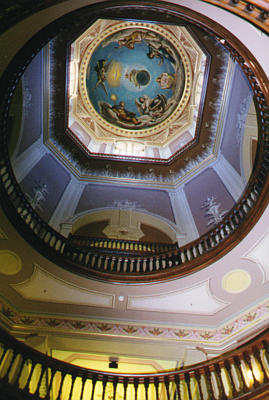 In 1884 Father Sorin envisioned the completion of his dream which was
finally accomplished in 1886, he died seven years later:
In 1884 Father Sorin envisioned the completion of his dream which was
finally accomplished in 1886, he died seven years later:
The exterior of the beautiful Dome of Notre Dame is now finished, thank God! and not a dollar expended on it will ever be regretted. It is the grand feature of the place -- one of the chief ornaments of the West. But, beautiful as it looks, it is scarcely anything compared to what it will soon be, when covered, as originally intended, with the heavy and imperishable gilding of the purest gold which will reflect magically through the day the rays of the sun, and at night turn darkness into bright light, from the electric crown of twelve stars with which the whole figure of the Blessed Virgin is to be clothed, typifying the prophecy: And there appeared a great wonder in heaven: a woman clothed with the sun, and the moon under her feet, and on her head a crown of twelve stars (Apoc., xii, i). What a beautiful sight! -- one that has never been seen in this country.(92)
-- Sorin
The Scholastic reported another approval: "Signor Gregori who is quite familiar with the best domes in the world is delighted with the new Dome of Notre Dame."(93) Signor Gregori was the artist who painted the interior of Sacred Heart Church. He also painted the inner Dome and the murals on the main floor of the Administration Building.
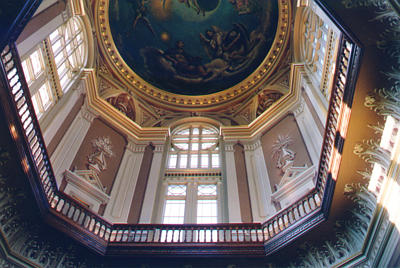
When this school, Our Lady's school, grows a bit more, I shall raise her aloft so that, without asking, all men shall know why we have succeeded here. To that lovely Lady, raised high on a dome, a Golden Dome, men may look and find the answer.(94)
In the 1993 Dome (95) the first close-up color photograph of the statue on the Dome was published in the yearbook. The delicately modeled face, the exquisite drapery of Our Lady's gown, the crescent moon and the serpent visible at her feet were captured on film by Bill Mowle. Such detail could only have been guessed at before from a distance. It is a beautiful statue and a most unusual photograph.
Another brief poem in the Scholastic celebrates her glowing image:
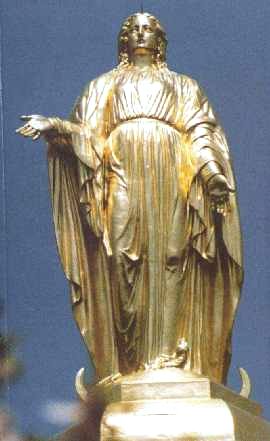
|
Silent she stands, Our Lady of the Light Whose mercy keeps a watch upon the waters; Over our hearts, by day or dreamy night, May she hold sway, Fairest of Daughters.(96) |